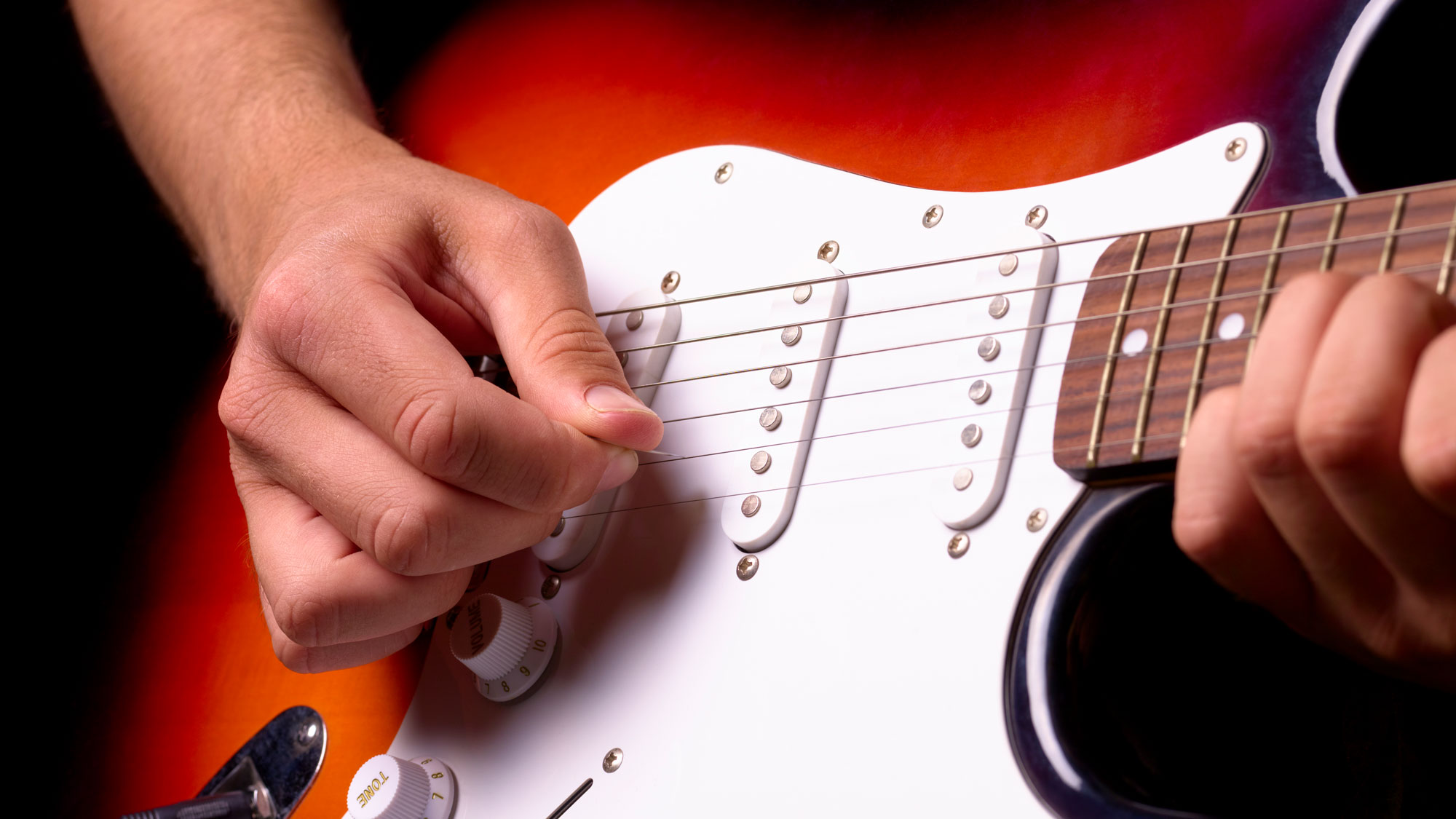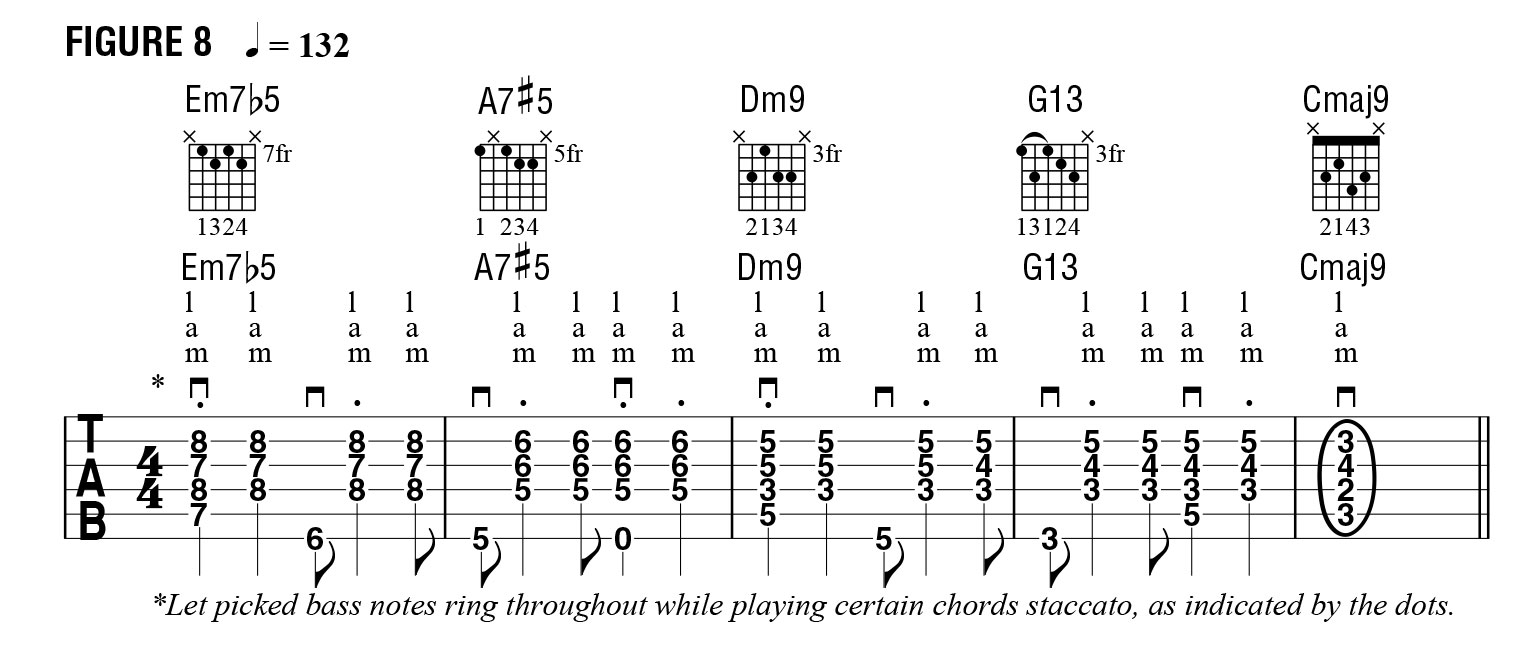
Guitarists are always searching for new ways to express their musical ideas on the instrument.
Be it a new chord voicing, scale, arpeggio, lick or riff, their attention is most often focused on the fretboard. But a lot of musical expression comes from the pick hand, where tone, dynamics, and the elusive touch factor are all produced in great part.
There are several ways to attack a string and cause it to vibrate and create sound, such as flatpicking, fingerpicking, tapping and slapping, but one of the most versatile, style-crossing techniques is what has come to be known as hybrid picking, which refers to the use of a flatpick in conjunction with the bare fingers.
There are variations on the technique, but generally, they all follow the same basic guidelines: the pick, held in the conventional manner between the thumb and index finger, strikes downward on lower strings, and the middle and/or ring fingers (and sometimes the pinkie) pluck upward on the higher strings, either alternately or simultaneously.
Advantages of hybrid picking
For rhythm guitar applications, hybrid picking lets you pick two or more strings at precisely the same time, making it possible to attack two-, three- and four-note chords the way a piano player would, whereas a standard strumming technique with a pick would require you to sound the notes in succession, one at a time. Hybrid picking also allows you to easily and cleanly attack nonadjacent strings together for a wide separation between the notes of a chord or double-stop.
For arpeggiating – playing the notes of a chord one at a time – hybrid picking can often produce smoother or more desirable results than straight fingerpicking or flatpicking and enable you to give the bass notes a crisp, flatpicked articulation while achieving a softer, fingerpicked sound on the higher strings. And unlike fingerpicking, hybrid picking lets you quickly revert to strumming or alternate picking, or vice versa, which comes in handy in many playing situations.
When it comes to soloing, hybrid picking can considerably up the ante by making it easier to play flashy licks. The technique can be used in many situations to conveniently increase speed with less movement and effort than what would be required with flatpicking, especially when it comes to one-note-per-string patterns, such as string-skipping phrases, chicken-pickin’ licks and hot banjo rolls.
Intrigued? Well, let’s get started!
All the latest guitar news, interviews, lessons, reviews, deals and more, direct to your inbox!
Basic hybrid picking exercises
FIGURES 1a–f are designed to get your hybrid picking chops up and running at a fundamental level. You can grip an open D chord shape for all of these exercises, so that you can concentrate on just the pick hand.
Our first exercise (FIGURE 1a) represents a primary hybrid-picking move: picking a downstroke on a lower string (in this case, the D string) with the pick, and picking an upstroke on an adjacent higher string (here the G) with the middle finger.
If you’re in the habit of holding the pick with your thumb, index finger and middle finger, you’ll need to make an adjustment and clasp the pick between your thumb and index finger only. This frees up your middle finger to immediately pluck the G-string note.
If you have short nails, just use the fleshy fingertip to “snap” the string. If your nails are medium length, you might want to let the edge of the nail, the part closest to the index finger, catch the string slightly as the finger passes over it. This will produce a slightly brighter attack.
FIGURE 1b will help get your ring finger into hybrid-picking shape. This exercise may feel a little more awkward because of the string jump. Again, start by picking a downstroke on the open D-string with the pick, and then pick an upstroke on the B-string note with your ring finger. Feel free to catch the G string with a bit of your fingernail if possible.
FIGURE 1c is a pattern-based exercise that incorporates both the middle and ring fingers. Try not to let the fingers come down onto the ringing strings between strokes and inadvertently mute them, and keep them up and hovering (like spider legs) ready to strike the strings at the appropriate moment.
FIGURE 1d is an arpeggio exercise that rolls up and down the notes of a D5 chord.
FIGURE 1e has you picking a double-stop (two-note chord) on adjacent strings. The pick handles the droning open-D pedal tone while the middle and ring fingers pick the G- and B-string notes simultaneously.
FIGURE 1f encompasses a full open D chord, played with an alternating bass line. The pick alternately hits the root and fifth of the chord (D and A, respectively) while the middle and ring fingers pick the double-stops on the higher pairs of adjacent strings.
As you work your way through this pattern, and all the previous exercises, strive for accurate articulation of the notes, an even volume level between the notes attacked with the pick and bare fingers, and a steady rhythm and tempo.
Rhythm guitar applications
Now that we’ve gotten the fundamentals down, let’s take a look at some useful applications of hybrid picking for rhythm guitar styles.
FIGURE 2 is an example of arpeggiating chords for a rock ballad in 12/8 meter, à la I Want You (She’s So Heavy) by the Beatles. Notice that the pick uses an upstroke on each return to the G string after the B and high E strings are fingerpicked.
This is purely a matter of taste and personal preference, as a downstroke could easily be substituted, especially when playing at a slow tempo. It’s important to note here that while this example could be played entirely pick-style, many players find it easier to play rhythmically “in the pocket” and with more precision using hybrid picking.
FIGURE 3 is a piano-like pedal-point chord figure similar to Aerosmith’s Dream On. Here, the upper two notes of each chord are fingerpicked together by the ring and middle fingers and in opposition to the G-string pedal tone (B), which is flatpicked with downstrokes. Try to stay consistent with your timing, and use the fret-hand fingering suggestions to help with the unusual chord shapes.
FIGURE 4 is a ’70s-rock-style example that has you arpeggiating the chord changes with a specific hybrid-picking pattern. Following the first note in each bar, the pick-hand pattern never changes through each successive bar.
FIGURE 5 is a classic example of an alternating bass-line figure widely used in folk and country styles. The key here is to keep the flatpicked notes, the root and fifth, flowing in a steady quarter-note rhythm while the fingers pick the notes that fall on the eighth-note upbeats.
FIGURE 6 is a progressive-rock-style example that strews fingerpicked triads across the D, G and B strings while the pick drives an open-A string pedal with palm-muted “pumping” downstrokes.
Notice that the pinkie comes into play here to pick all the B-string notes. While not often used in hybrid picking, the pinkie comes in handy in certain situations such as this.
FIGURE 7 demonstrates a musically advantageous and tasteful application of hybrid picking. The barre chords in the example are very commonplace, but when played in “broken form” like this with hybrid picking, they take on a whole new character and added appeal, with an emphasis on the intervals of sixths and sevenths.
FIGURE 8 is an example of a syncopated, Latin jazz–style fingerpicked part adapted for hybrid picking. Although more harmonically complex than the previous examples, this passage is essentially just another variation on the alternating bass-line patterns introduced in FIGURES 1f and 5 and is actually not very difficult to play.
Lead guitar applications
FIGURES 9a–g are exercises based on the ever-popular A minor pentatonic scale’s (A C D E G) fifth-position “box” shape and demonstrate typical hybrid-picking moves used by “hot country” lead guitarists, as well as country-influenced rock and metal players.
FIGURES 9a–c ascend the pattern in a series of adjacent-string moves, while FIGURES 9d–f descend with string-skipping maneuvers. As you play through these examples, keep accuracy, dynamics and timing in mind, as emphasized earlier.
Hybrid picking often comes in handy for licks based on a cycled passage – a series of repeating notes – that incorporate frequent string crosses.
FIGURE 10a offers an example of a three-note sequence that is played three times before moving to a similar move in bar 2. The tempo marking is just a starting point; to help you build up speed, keep your middle and ring fingers resting on their designated strings, cocked and ready to go for when it’s time to “pull the trigger.”
FIGURE 10b employs a four-note sequence that is played three times before resolving to a bluesy, double-stop hammer-on.
FIGURE 11a snakes its way down the A minor pentatonic scale in a series of adjacent-string crosses. Feel free to emphasize the upper notes with an aggressive snap from the middle finger.
FIGURE 11b illustrates how just a touch of hybrid picking can spice up a standard rock lead phrase. Again, pull extra hard on the high-E string note.
FIGURE 12 is a progressive funk-rock example that features string-skipping maneuvers that produce wide intervals. Stay faithful to the hybrid picking and fret-hand fingering suggestions and you’ll probably find you can get this up to lightening speed with a little bit of practice.
FIGURE 13 is an example of the country technique known as chicken pickin’, but in more of a rock context. Based on Joe Walsh’s classic intro to the James Gang song Funk #49, it’s performed almost entirely on the G string. This one is tricky, so take some extra time with it, be patient and make sure you’re executing it correctly.
Regarding the fret hand, launch the whole-step bend and hold it throughout the first bar. Release the bend by a one half step on the and of beat one in bar 2 and sustain the bend until the and of beat three. The final bend is just a quarter-step “curl.”
Regarding the pick hand, make sure you mute each “ghost” note (indicated by an X) with the tip of your middle finger as you pick the string with a downstroke.
FIGURE 14 is pure country. Although it’s crafted from the C major pentatonic-add-b3 scale (sometimes referred to as the bluegrass scale or major blues scale: C D Eb E G A), it may be easier to think of it as the A blues scale (A C D Eb E G) with C as the root note instead of A. In any case, accented hybrid picking and string muting give the lick that signature chicken-pickin’ sound.
FIGURE 15 is a “banjo roll” lick that emulates the celebrated, fiery banjo lines heard in Earl Scruggs’ bluegrass classic Foggy Mountain Breakdown.
Banjo rolls are a fixture in the hot country lead-guitar style of players like Albert Lee, Brent Mason and Brad Paisley, and they also can be crafted to work well in a rock context, as players like Zakk Wylde, John 5 and Eric Johnson have demonstrated with dazzling results.
Start very slow with this example, getting the fingerpicking pattern down first. Make sure you allow the B and high E strings to ring together.
FIGURE 16, a country-rock-style example, utilizes banjo-roll techniques to blaze a path across a G–Fsus2–C–G chord progression. Be sure to keep the open G string ringing throughout.
For the grand finale, FIGURE 17 presents a cool, challenging lick inspired by some of Wylde’s breathtaking hybrid-picking moves.
Using the G blues scale (G Bb C Db D F) as the catalyst, this example includes banjo-style rolls, cycled patterns and wide-interval open-string hammer-ons and pull-offs, capped off by a screaming pinch harmonic (P.H.) and whole-step bend, adorned with some hearty, macho finger vibrato.
A Musicians Institute teacher since 1989, Tom Kolb has published many books on guitar technique and been featured in instructional DVDs by Hal Leonard. He is also the author of the Soloing Strategies column in Guitar World magazine.


















